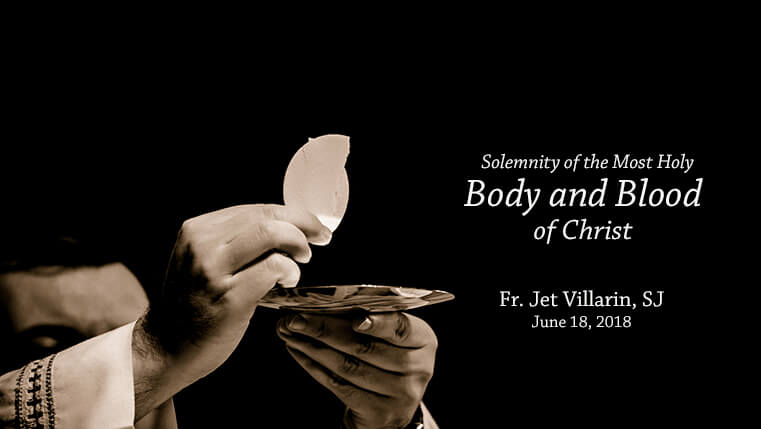


Fr. Jose Ramon T Villarin, SJ
The Solemnity of the Most Holy Body and Blood of Christ
June 3, 2018
Now there’s a picturesque Filipino word. It means to draw or pull something out from some depth. Used these days, hugot suggests the drawing out of deep feelings and meanings. A song or line has hugot if it draws these affective movements from deep within us. Ang lalim ng hugot. The draw is deep.
It is a hopeful word. It implies that things, like words, even persons, have many layers and dimensions to them. What is real and true is not just on the surface. There’s more to life than meets the eye.
Unfortunately, our eyes can be lazy. We can choose to just read the surface. This happens with literalism, when meaning tragically tapers to just the literal sense, the letter of words and even laws. We see this in the extremist and fundamentalist interpretation of sacred readings. We see this in the dangerous legalism of the civil or religious Pharisees of today. We see this in how we judge and troll each other on the shallow basis of skin, religious, or political color.
We will not however let our eyes be lazy on this Solemnity of the Most Holy Body and Blood of Christ (formerly Corpus Christi). On the surface, our eyes might just glaze over, seeing a bunch of people listening to some words being spoken, and sharing bread and wine on a table. On this Solemnity, we will go beneath the surface and discover that God is in this gathering too, that he is present to us in every Eucharistic celebration and that his presence is more than just poetic or symbolic.
We will go through layers of time to remember that evening of the Passover when “he took bread, said the blessing, broke it, gave it to them, and said, ‘Take it; this is my body.’ Then he took a cup, gave thanks, and gave it to them, and they all drank from it. He said to them, ‘This is my blood of the covenant, which will be shed for many.’”
We will remember and see again that the Eucharist is the memorial of Christ’s Passover, this defining act of deliverance wrought for us by the passion, death, and resurrection of the Lamb of God. More than just a retrospective ritual, the Eucharist is a sacrament that signifies and makes present today the grace of freedom that is being offered through the sacrifice of Christ’s redeeming love. This is the ultimate hugot or draw of the Eucharist. In every Eucharist, in every communion, we draw life from Christ’s sacrifice. We draw breath from every breath drawn from God.
And so we learn to appreciate the breathtaking simplicity of the bread and wine on the table. The transcendent God could have chosen something more exquisite or extraordinary. Imagine receiving God through the body and blood of Christ under the ordinary species of bread and wine. Consider the utter immediacy of these sacramental signs and how radical it is to know that we can receive God without bursting and that we need not go very far to get God or for God to get us. Again, layers, dimensions. Hugot.
We could of course microscope the molecular makeup of bread and wine, and find nothing of Christ’s body and blood there. But that would be reading just one layer. Besides, even within that layer, despite all the astrophysics and particle tinkering we’ve done, we’re still pretty much in the dark about what physical matter is all about.
On a deeper layer, at the level of mystery and faith, we know that in every Eucharist, when we receive Christ, we allow his redeeming love to transform us. It is his love, received in communion with others, which empowers us to make an oblation of our lives, despite our wounds and reservations. It is his body and blood that transfigures us to become “bread for the hungry, wine for the weary” even if we are often vulnerable ourselves to hunger and weariness.
In such moments of communion, Christ sees us, sees beneath the surface of us, and patiently draws love from the depth of us. In these moments of Eucharistic conversion, not only bread and wine are changed to his body and blood. We ourselves become the body of Christ. Truly there is something about us, something more to us than meets the eye. In the Eucharist, we see a bit of this something. In the image and likeness of Christ’s cruciform love, we are recreated and redeemed. Again, layers, dimensions. Hugot.